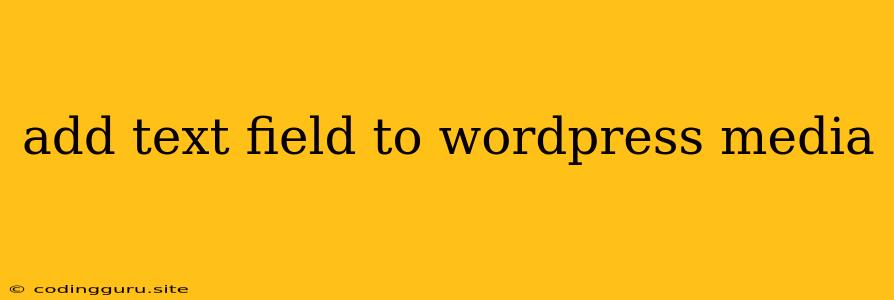Adding Text Fields to Your WordPress Media Library: A Guide
Want to add extra information to your WordPress media library? Whether you need to track copyright details, image dimensions, or any other specific data, you can achieve this by adding custom text fields to your media library. This guide will show you how to add text fields to your WordPress media library and leverage this functionality to better manage your media assets.
Why Add Text Fields?
Adding text fields to your WordPress media library offers several advantages:
- Organized Media: Easily categorize and filter your media based on specific criteria. Imagine being able to quickly find all images with a specific license, or all videos shot in a particular location.
- Detailed Metadata: Store valuable information about your media, such as copyright details, source, usage rights, or other relevant details.
- Enhanced Workflow: Streamline your media management process by adding custom fields that reflect your unique needs and workflows.
Methods for Adding Text Fields:
There are two primary methods for adding text fields to your WordPress media library:
- Using Plugins: This is the easiest option, especially for beginners. Many plugins offer user-friendly interfaces and a range of options for customizing your text fields.
- Using Code (Custom Fields): This method requires some technical knowledge but offers greater flexibility and control over how your text fields function.
Using Plugins:
1. Media Library Extended:
- Features: Adds custom fields to your WordPress media library, allowing you to store additional information about each media file. You can create custom fields for text, numbers, dropdown menus, checkboxes, and more.
- Benefits: Easy to use, offers a wide range of field types, supports multiple fields per media item.
2. Meta Box:
- Features: A powerful plugin that allows you to create custom meta boxes for various WordPress elements, including media. You can add text fields, along with other field types, to your media library.
- Benefits: Highly customizable, allows you to create complex meta boxes with different field types, integrates well with other plugins.
Using Custom Fields:
This method involves adding code to your WordPress theme or child theme. Here's a basic example of how to create a custom text field for media:
function add_custom_media_field($form_fields, $post) {
$form_fields['custom_field'] = array(
'label' => 'Custom Field',
'input' => 'text',
'value' => get_post_meta($post->ID, 'custom_field', true),
);
return $form_fields;
}
add_filter('attachment_fields_to_edit', 'add_custom_media_field', 10, 2);
function save_custom_media_field($post_id) {
if ( isset($_POST['attachments']) ) {
foreach ($_POST['attachments'] as $attachment_id) {
if ( isset($_POST['custom_field'][$attachment_id]) ) {
update_post_meta($attachment_id, 'custom_field', sanitize_text_field($_POST['custom_field'][$attachment_id]));
}
}
}
}
add_action('edit_attachment', 'save_custom_media_field');
Explanation:
- This code defines a function
add_custom_media_fieldwhich adds a new field named "Custom Field" to the media upload form. - The
inputparameter specifies that this field is a text input. - The
valueparameter retrieves any existing value for this custom field associated with the media item. - The
save_custom_media_fieldfunction handles saving the value entered in the custom field to the media item's metadata.
Important:
- For more complex scenarios, you may need to write additional code to handle different field types, validation, and other custom requirements.
- Ensure you're comfortable working with PHP and understand basic WordPress development before attempting this method.
Conclusion:
Adding text fields to your WordPress media library can greatly enhance your media management capabilities. Choose the method that best suits your needs and technical expertise. Whether you use plugins or custom code, you'll gain valuable tools for organizing, filtering, and enriching your media assets.
